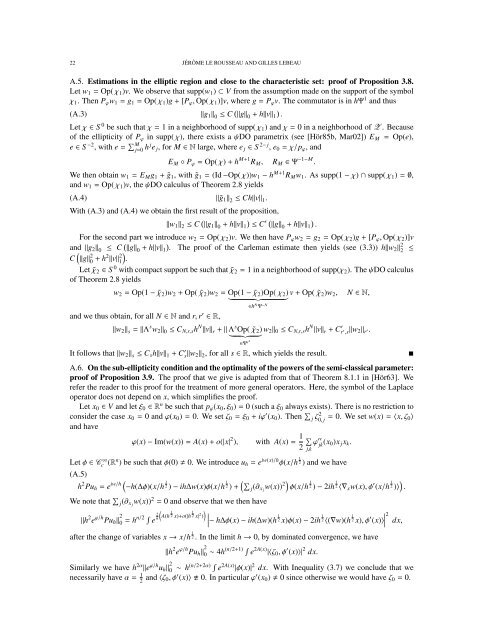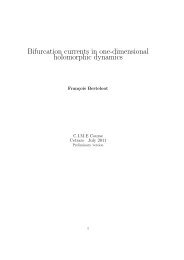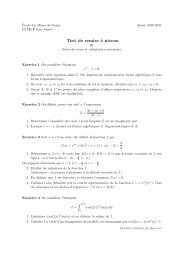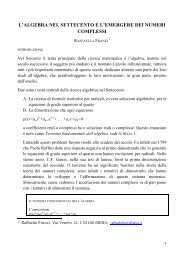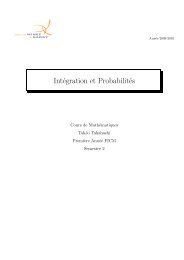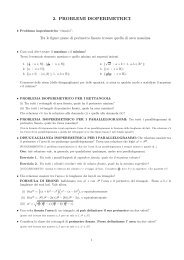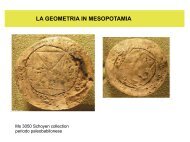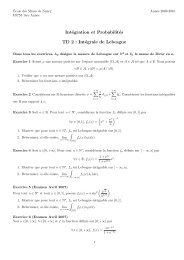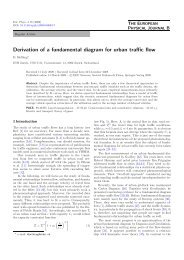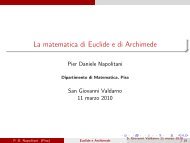on carleman estimates for elliptic and parabolic operators ...
on carleman estimates for elliptic and parabolic operators ...
on carleman estimates for elliptic and parabolic operators ...
You also want an ePaper? Increase the reach of your titles
YUMPU automatically turns print PDFs into web optimized ePapers that Google loves.
22 JÉRÔME LE ROUSSEAU AND GILLES LEBEAU<br />
A.5. Estimati<strong>on</strong>s in the <strong>elliptic</strong> regi<strong>on</strong> <strong>and</strong> close to the characteristic set: proof of Propositi<strong>on</strong> 3.8.<br />
Let w 1 = Op( χ 1 )v. We observe that supp(w 1 ) ⊂ V from the assumpti<strong>on</strong> made <strong>on</strong> the support of the symbol<br />
χ 1 . Then P ϕ w 1 = g 1 = Op( χ 1 )g + [P ϕ , Op( χ 1 )]v, where g = P ϕ v. The commutator is in hΨ 1 <strong>and</strong> thus<br />
(A.3) ‖g 1 ‖ 0 ≤ C ( ‖g‖ 0 + h‖v‖ 1<br />
) .<br />
Let χ ∈ S 0 be such that χ = 1 in a neighborhood of supp( χ 1 ) <strong>and</strong> χ = 0 in a neighborhood of Z . Because<br />
of the <strong>elliptic</strong>ity of P ϕ in supp( χ), there exists a ψDO parametrix (see [Hör85b, Mar02]) E M = Op(e),<br />
e ∈ S −2 , with e = ∑ M<br />
j=0 h j e j , <strong>for</strong> M ∈ N large, where e j ∈ S 2− j , e 0 = χ/p ϕ , <strong>and</strong><br />
E M ◦ P ϕ = Op( χ) + h M+1 R M , R M ∈ Ψ −1−M .<br />
We then obtain w 1 = E M g 1 + ˜g 1 , with ˜g 1 = (Id −Op( χ))w 1 − h M+1 R M w 1 . As supp(1 − χ) ∩ supp( χ 1 ) = ∅,<br />
<strong>and</strong> w 1 = Op( χ 1 )v, the ψDO calculus of Theorem 2.8 yields<br />
(A.4) ‖˜g 1 ‖ 2 ≤ Ch‖v‖ 1 .<br />
With (A.3) <strong>and</strong> (A.4) we obtain the first result of the propositi<strong>on</strong>,<br />
‖w 1 ‖ 2 ≤ C ( ‖g 1 ‖ 0 + h‖v‖ 1<br />
) ≤ C<br />
′ ( ‖g‖ 0 + h‖v‖ 1<br />
) .<br />
For the sec<strong>on</strong>d part we introduce w 2 = Op( χ 2 )v. We then have P ϕ w 2 = g 2 = Op( χ 2 )g + [P ϕ , Op( χ 2 )]v<br />
<strong>and</strong> ‖g 2 ‖ 0 ≤ C ( ‖g‖ 0 + h‖v‖ 1<br />
) . The proof of the Carleman estimate then yields (see (3.3)) h‖w2 ‖ 2 2 ≤<br />
C ( ‖g‖ 2 0 + h2 ‖v‖ 2 1)<br />
.<br />
Let ˜χ 2 ∈ S 0 with compact support be such that ˜χ 2 = 1 in a neighborhood of supp(χ 2 ). The ψDO calculus<br />
of Theorem 2.8 yields<br />
w 2 = Op(1 − ˜χ 2 )w 2 + Op( ˜χ 2 )w 2 = Op(1 − ˜χ 2 )Op( χ 2 )<br />
}{{}<br />
v + Op( ˜χ 2 )w 2 , N ∈ N,<br />
∈h N Ψ −N<br />
<strong>and</strong> we thus obtain, <strong>for</strong> all N ∈ N <strong>and</strong> r, r ′ ∈ R,<br />
‖w 2 ‖ s = ‖Λ s w 2 ‖ 0 ≤ C N,r,s h N ‖v‖ r + ‖ Λ s Op( ˜χ 2 )<br />
}{{}<br />
∈Ψ r′ w 2 ‖ 0 ≤ C N,r,s h N ‖v‖ r + C ′ r ′ ,s‖w 2 ‖ r ′.<br />
It follows that ‖w 2 ‖ s ≤ C s h‖v‖ 1 + C ′ s‖w 2 ‖ 2 , <strong>for</strong> all s ∈ R, which yields the result.<br />
A.6. On the sub-<strong>elliptic</strong>ity c<strong>on</strong>diti<strong>on</strong> <strong>and</strong> the optimality of the powers of the semi-classical parameter:<br />
proof of Propositi<strong>on</strong> 3.9. The proof that we give is adapted from that of Theorem 8.1.1 in [Hör63]. We<br />
refer the reader to this proof <strong>for</strong> the treatment of more general <strong>operators</strong>. Here, the symbol of the Laplace<br />
operator does not depend <strong>on</strong> x, which simplifies the proof.<br />
Let x 0 ∈ V <strong>and</strong> let ξ 0 ∈ R n be such that p ϕ (x 0 , ξ 0 ) = 0 (such a ξ 0 always exists). There is no restricti<strong>on</strong> to<br />
c<strong>on</strong>sider the case x 0 = 0 <strong>and</strong> ϕ(x 0 ) = 0. We set ζ 0 = ξ 0 + iϕ ′ (x 0 ). Then ∑ j ζ0, 2 j = 0. We set w(x) = 〈x, ζ 0〉<br />
<strong>and</strong> have<br />
ϕ(x) − Im(w(x)) = A(x) + o(|x| 2 ), with A(x) = 1 ∑<br />
2<br />
j,k<br />
ϕ ′′<br />
jk (x 0)x j x k .<br />
Let φ ∈ Cc ∞ (R n ) be such that φ(0) 0. We introduce u h = e iw(x)/h φ(x/h 1 2 ) <strong>and</strong> we have<br />
(A.5)<br />
h 2 Pu h = e ( iw/h −h(∆φ)(x/h 1 1<br />
(∑<br />
2 ) − ih∆w(x)φ(x/h 2 ) + j(∂ x j<br />
w(x)) 2) φ(x/h 1 1<br />
)<br />
2 ) − 2ih 2 〈∇x w(x), φ ′ (x/h 1 2 )〉 .<br />
We note that ∑ j(∂ x j<br />
w(x)) 2 = 0 <strong>and</strong> observe that we then have<br />
(<br />
‖h 2 e ϕ/h Pu h ‖ 2 0 = h n/2 ∫ e 2 h A(h 1 2 x)+o(|h 1 )) ∣<br />
2 x| 2 ∣∣∣ − h∆φ(x) − ih(∆w)(h 1 1<br />
1<br />
2 x)φ(x) − 2ih 2 〈(∇w)(h 2 x), φ ′ (x)〉<br />
∣ 2 dx,<br />
after the change of variables x → x/h 1 2 . In the limit h → 0, by dominated c<strong>on</strong>vergence, we have<br />
‖h 2 e ϕ/h Pu h ‖ 2 0 ∼ 4h (n/2+1) ∫ e 2A(x) |〈ζ 0 , φ ′ (x)〉| 2 dx.<br />
Similarly we have h 2α ‖e ϕ/h u h ‖ 2 0 ∼ h (n/2+2α) ∫ e 2A(x) |φ(x)| 2 dx. With Inequality (3.7) we c<strong>on</strong>clude that we<br />
necessarily have α = 1 2 <strong>and</strong> 〈ζ 0, φ ′ (x)〉 0. In particular ϕ ′ (x 0 ) 0 since otherwise we would have ζ 0 = 0.


